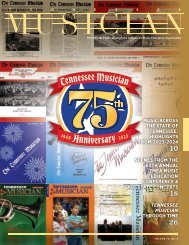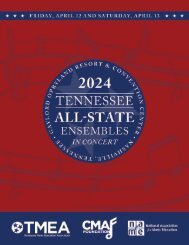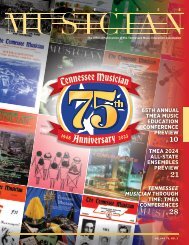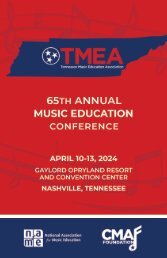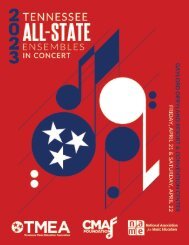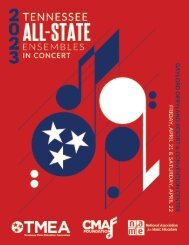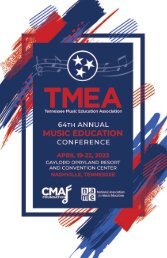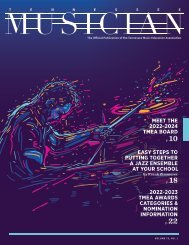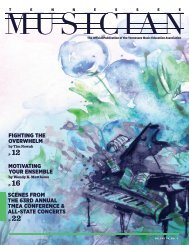You also want an ePaper? Increase the reach of your titles
YUMPU automatically turns print PDFs into web optimized ePapers that Google loves.
TM<br />
National Core Arts Standards: An Introduction<br />
Johnathan Vest<br />
Standards. If you are in the field of education,<br />
then that word immediately brings something to<br />
mind. That something maybe positive, like achievement<br />
or success. You may correlate standards with<br />
negative terms like accountability or testing (and<br />
whether these terms are negative depends on who you<br />
ask). Or, it may only elicit an eye roll, signifying your<br />
exasperation with one more thing – one more fad, one<br />
more idea that will eventually be replaced by the next<br />
of that change, and it presents a real challenge to our<br />
discipline. Music has never been considered a “core”<br />
subject by the traditional educational establishment,<br />
but we haven’t seen a nationwide focus away from the<br />
arts like this since the launch of Sputnik in 1957<br />
and the ensuing “star wars.” (It is worth mentioning<br />
that there is a STEM to STEAM Caucus that has been<br />
formed in Washington, D.C. [with the “A” representing<br />
the arts], but even this seems more focused on<br />
visual art and graphic design than music).<br />
“Music educators (as well as other non value-added tested<br />
subject area teachers) have not been as susceptible to the<br />
frequency of change in standards and curricula as our<br />
colleagues in math and language”<br />
group of people after the next election cycle.<br />
Why new standards? Music educators (as well<br />
as other non value-added tested subject area teachers)<br />
have not been as susceptible to the frequency of<br />
change in standards and curricula as our colleagues<br />
in math and language. Since 1994, the Nine National<br />
Standards for Music Education have been in place.<br />
These standards are fairly general, so many states<br />
expanded them to align with more specific curricular<br />
models (Danielson, Marzano, etc.) 20 years, however,<br />
is a long time, and the educational, scientific and<br />
cultural landscapes have changed drastically since<br />
then. The focus on STEM courses (science, technology,<br />
engineering and math), for instance, is part<br />
If music educators are going to present our<br />
subject as vital to the education of the whole child,<br />
then we must prove that it indeed is. We must show<br />
it. It’s not enough to tell people that what we do<br />
makes our students more thoughtful, more analytical,<br />
more literate, and more human; we must provide<br />
data. Music educators also take pride in how creative<br />
our students are becoming by participating in our<br />
music classes and ensembles. Creation is at the top<br />
of Bloom’s Taxonomy (1994). Way to go, us! I hate<br />
to burst the bubble, but there is nothing inherently<br />
creative about reading notes off a page. <strong>No</strong>te reading<br />
is a very basic skill, near the bottom of Bloom’s<br />
Taxonomy. Likewise, interpreting the gestures of<br />
28 www.tnmea.org<br />
TM | <strong>Vol</strong>ume <strong>67</strong> number 1



